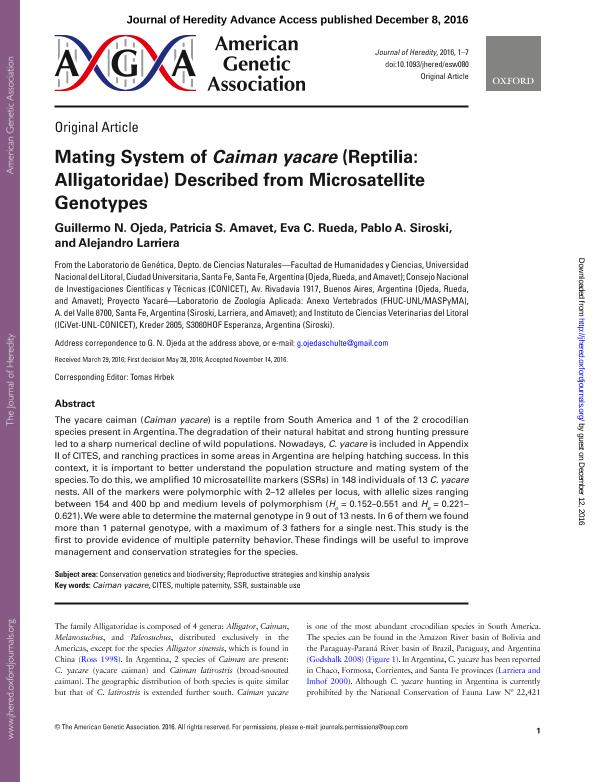Artículo
Mating system of Caiman yacare (Reptilia: Alligatoridae) described from microsatellite genotypes
Ojeda, Guillermo Nicolás ; Amavet, Patricia Susana
; Amavet, Patricia Susana ; Rueda, Eva Carolina
; Rueda, Eva Carolina ; Siroski, Pablo Ariel
; Siroski, Pablo Ariel ; Larriera, Alejandro
; Larriera, Alejandro
 ; Amavet, Patricia Susana
; Amavet, Patricia Susana ; Rueda, Eva Carolina
; Rueda, Eva Carolina ; Siroski, Pablo Ariel
; Siroski, Pablo Ariel ; Larriera, Alejandro
; Larriera, Alejandro
Fecha de publicación:
03/2017
Editorial:
Oxford Univ Press Inc
Revista:
Journal of Heredity
ISSN:
0022-1503
Idioma:
Inglés
Tipo de recurso:
Artículo publicado
Clasificación temática:
Resumen
The yacare caiman (Caiman yacare) is a reptile from South America and 1 of the 2 crocodilian species present in Argentina. The degradation of their natural habitat and strong hunting pressure led to a sharp numerical decline of wild populations. Nowadays, C. yacare is included in Appendix II of CITES, and ranching practices in some areas in Argentina are helping hatching success. In this context, it is important to better understand the population structure and mating system of the species. To do this, we amplified 10 microsatellite markers (SSRs) in 148 individuals of 13 C. yacare nests. All of the markers were polymorphic with 2-12 alleles per locus, with allelic sizes ranging between 154 and 400 bp and medium levels of polymorphism (Ho = 0.152-0.551 and He = 0.221-0.621). We were able to determine the maternal genotype in 9 out of 13 nests. In 6 of them we found more than 1 paternal genotype, with a maximum of 3 fathers for a single nest. This study is the first to provide evidence of multiple paternity behavior. These findings will be useful to improve management and conservation strategies for the species.
Palabras clave:
Caiman Yacare
,
Cites
,
Multiple Paternity
,
Ssr
,
Sustainable Use
Archivos asociados
Licencia
Identificadores
Colecciones
Articulos(CCT - SANTA FE)
Articulos de CTRO.CIENTIFICO TECNOL.CONICET - SANTA FE
Articulos de CTRO.CIENTIFICO TECNOL.CONICET - SANTA FE
Citación
Ojeda, Guillermo Nicolás; Amavet, Patricia Susana; Rueda, Eva Carolina; Siroski, Pablo Ariel; Larriera, Alejandro; Mating system of Caiman yacare (Reptilia: Alligatoridae) described from microsatellite genotypes; Oxford Univ Press Inc; Journal of Heredity; 108; 2; 3-2017; 135-141
Compartir
Altmétricas



